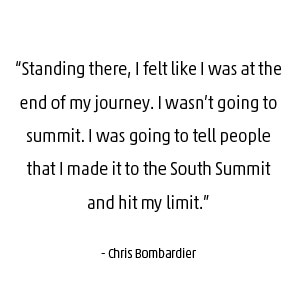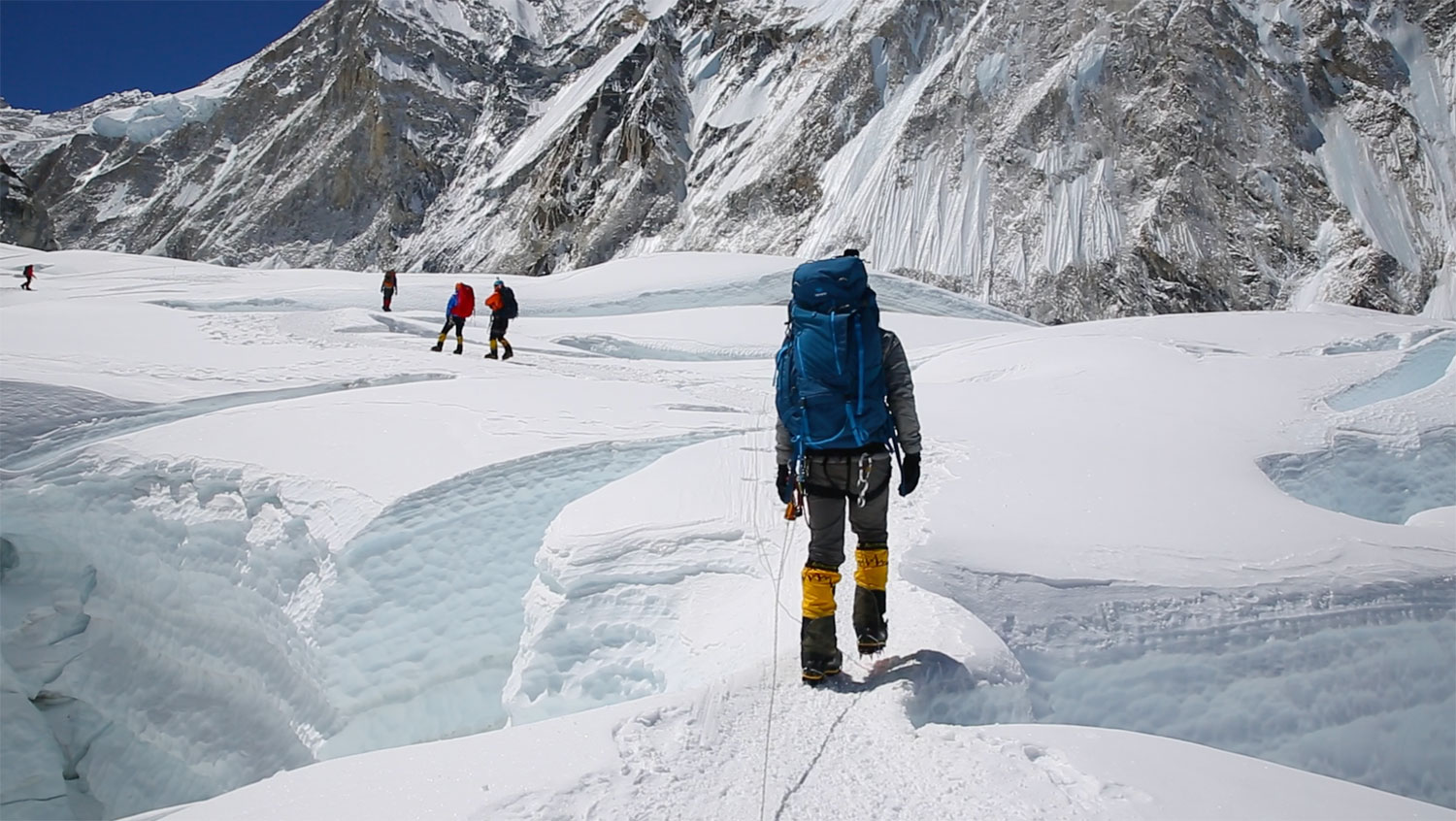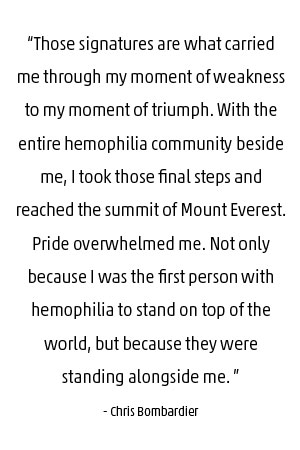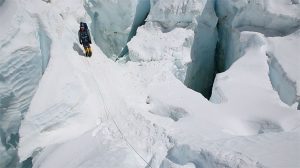Chipping away at the Seven Summits, Mountainsmith Athlete is the first hemophiliac to summit Everest, raising awareness for blood disease and healthcare around the world.

I stood on the South Summit of Everest, 325ft beneath my goal. I had been climbing for 10 hours in the bitter cold. I only had a sip of water and no food. Every step took my breath away. I looked up and saw the knife-edge ridge of rock and ice leading to the Hillary Step. On one side you can see 8,000ft down to Camp 2 in Nepal and on the other, 11,000ft down into Tibet.
Standing there, I felt like I was at the end of my journey. I wasn’t going to summit. I was going to tell people that I made it to the South Summit and hit my limit. The first priority of my trip had always been returning safely to my wife and loved ones. In my mind, taking a single step onto that ridge was too risky. 
I sat down on a chunk of snow and asked myself: would I really be okay turning around here? I knew my family would still be proud of me. After a few minutes of deliberation, I turned to Tashi, our Sirdar (head Sherpa) and said, “I think I’m done.” Without hesitation, Tashi replied, “Chris, you can do this! You are here for a reason. You have a mission and a purpose. You can do this!” He started walking towards the ridgeline and as he passed me, Tashi took one of the carabiners tethered to his harness, clipped it through my carabiner on the fixed line, and kept walking.
So many emotions flooded through me in that moment, the first one being fear. But once I started up the ridge, I thought of an item that I had carried in my pocket every day of this journey: a flag signed by members of the hemophilia community in Nepal. The flag reminded me that Tashi was right – this climb wasn’t just about my own personal journey, but one of an entire global community. You see, I also have the life-threatening chronic bleeding disorder called hemophilia, but because of the access I have had to treatment as an American, my life looks incredibly different than those living with hemophilia in many parts of the world. My mission in climbing Everest was to bring attention to this disparity in care around the globe.

Many people hear the word “hemophilia” and automatically think of someone that could die from a papercut. That’s not accurate. At 32 years old, I have had much worse than a papercut and I’m still here! But living with hemophilia is tough. Throughout my life I have struggled through bleeding into muscles and joints, which is incredibly painful. Seemingly minor events that would lead to small injuries for most people would routinely result in my being on crutches for days with painful swelling. But I always had access to medication, and as I have grown up my treatment has only gotten better. Because of this, I’ve been able to play sports and live a relatively normal life.
It wasn’t until my mid-twenties that I realized the truly devastating effects hemophilia could inflict. I travelled to Kenya as part of a humanitarian aid program for the hemophilia community there. Within the first 24 hours of being in the country, I saw a young man dying because no one in the hospital knew he had hemophilia. This is not unusual in developing countries given how rare hemophilia is (about 1 in 10,000 births) and the lack of education on bleeding disorders in many of these countries. Luckily, the team I came with recognized the swollen and immobile joints that accompanied the young man’s uncontrollable bleeding. We were able to give him some donated medicine and thankfully he ended up surviving. That experience showed me what it really meant to have hemophilia; what my life could’ve looked like had I been born in another country.

I had been into mountaineering for a few years before the trip to Kenya and was planning on heading to Kilimanjaro afterwards. I had started dreaming of the Seven Summits but didn’t know how climbing with hemophilia would go. I’d never started an IV above 9,000ft or climbed for five straight days; I didn’t know how my body would react. But after my experience with that patient, the meaning of the climb changed. Rather than climbing solely for my personal reasons, I wanted to see if my climbing could in some way benefit the global hemophilia community. I summited Kili two weeks later and couldn’t help but think about all the people suffering with this condition only a few hundred miles away from me. I was climbing a mountain, and they were struggling to live.

The feelings I had on the summit of Kilimanjaro came streaming back to me as I neared the summit of Everest. It was similar to the feeling I had on the summits of Aconcagua, Mt. Elbrus, Denali and Carstensz Pyramid. But Everest was a little different. Before this climb, I got to know the hemophilia community of Nepal. I learned about their day-to-day challenges, heard stories of a brother with hemophilia dying at 18 years old and legs being amputated due to complications from hemophilia. I saw people struggle to walk and force smiles through the unimaginable pain.
As I followed Tashi towards the summit, I pulled out the flag my Nepalese blood brothers had signed. I remembered how they smiled as they signed it and told me how proud they were to be a part of my climb. They thanked me for including them but the thanks should’ve been reversed. Those signatures are what carried me through my moment of weakness to my moment of triumph. With the entire hemophilia community beside me, I took those final steps and reached the summit of Mount Everest. Pride overwhelmed me. Not only because I was the first person with hemophilia to stand on top of the world, but because they were standing alongside me.
 I was greeted back in Kathmandu by the Nepal Hemophilia Society, and I was honored to present them with the flag. I don’t know if they realize how much they meant to me, but I’m determined to show them. I was very lucky to partner with filmmaker (and fellow hemophiliac) Patrick James Lynch and his production company Believe Limited to make a documentary about my time in Nepal and climb of Mount Everest. The film crew was with me throughout my travels and all the way to the summit. Hopefully we can bring our film, Bombardier Blood, back to Nepal and the community can see for themselves how much their strength in the face of adversity inspired me.
I was greeted back in Kathmandu by the Nepal Hemophilia Society, and I was honored to present them with the flag. I don’t know if they realize how much they meant to me, but I’m determined to show them. I was very lucky to partner with filmmaker (and fellow hemophiliac) Patrick James Lynch and his production company Believe Limited to make a documentary about my time in Nepal and climb of Mount Everest. The film crew was with me throughout my travels and all the way to the summit. Hopefully we can bring our film, Bombardier Blood, back to Nepal and the community can see for themselves how much their strength in the face of adversity inspired me.
There is still one more mountain in my journey towards climbing the Seven Summits – Mt. Vinson in Antarctica. I’d intended to climb Vinson two years ago but my permit was denied because of my hemophilia. Just another hurdle that I needed to overcome on this amazing journey. Fortunately, I recently found out that my permit has been approved so my focus has turned to training for that climb this December. As I prepare, I remember all the individuals I’ve met throughout the years that have helped me keep moving and keep my eye on the mission. Summiting these mountains has proven that, with adequate treatment, any dream is possible for people living with hemophilia. I’m proud to share these climbs with them all and will continue doing what I can to bring positive change and awareness for the global hemophilia community.
Check out the trailer for Bombardier Blood, coming soon.
The Making Of Bombardier Blood [Feature Documentary] from Ryan Gielen (Believe, LTD) on Vimeo.
Follow along to learn more about his experience on Everest and his push toward Vinson. Check out his website for more details on each summit as well as more on how you can help out Save One Life and the hemophiliac community around the world.
You are incredibly inspiring, Chris!